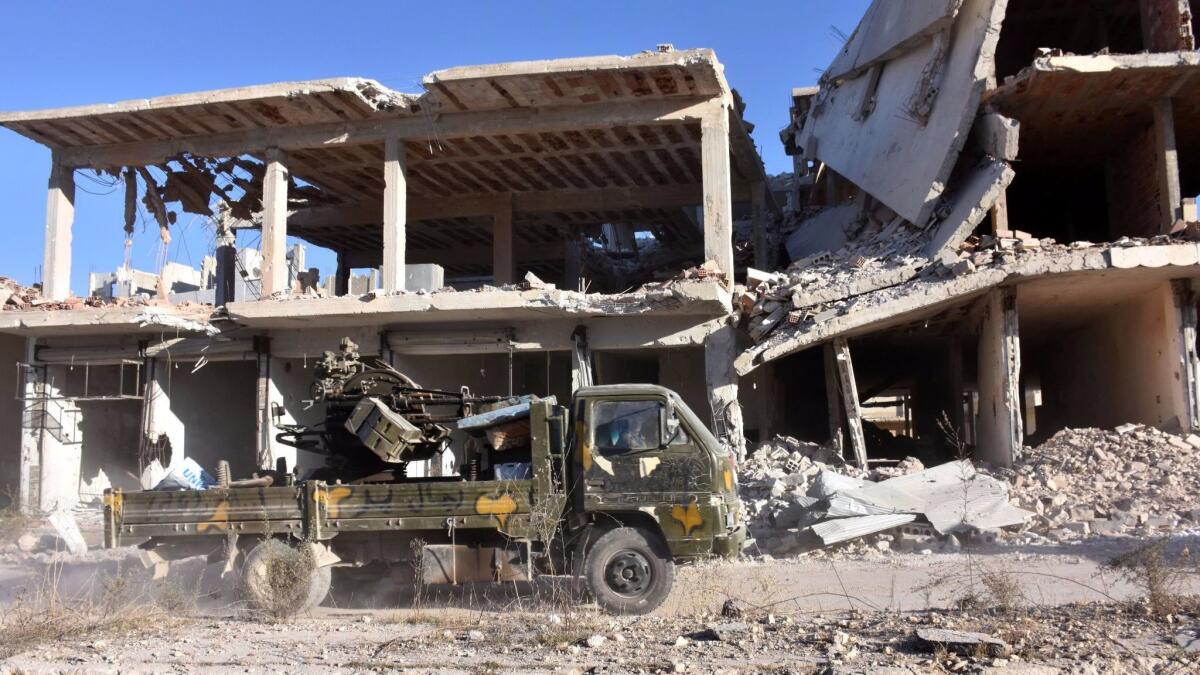Syrian forces capture major Aleppo neighborhood in blow to rebels

Building on dramatic advances over the last two days, Syrian pro-government troops stormed opposition-held neighborhoods in northeastern Aleppo on Monday, signaling an imminent defeat for the rebels who have waged a more than four-year battle for the once-thriving commercial city.
The new advances came a day after government troops, working in concert with Syrian and Palestinian militias, overran key rebel districts in the northern city, cleaving the opposition’s bastion in two.
The crucial surge Monday came on the 15th day of a Russian-backed, do-or-die government offensive to drive the rebel factions out of the city, which has been divided between the two sides since 2012.
Pro-government forces continued their rout on Monday, consolidating their control over the strategic Sakhour neighborhood and taking the entire northeastern section of the rebel enclave.
Thousands of residents streamed out of the enclave, making their way towards the areas taken by the government or to Sheik Maqsood, a Kurdish-dominated area to the north controlled by a Kurdish militia that has assisted the government against the rebels.
The Russian Center for Reconciliation, a Russian Defense Ministry organization that monitors the fighting in Syria, said on Monday that more than 3,000 people had left. However, the Syrian Observatory for Human Rights, a British-based watchdog group with activists in Syria, put the figure at 10,000.
The government also reclaimed Suleiman al Halabi, a district that is home to a vital water pumping station that services both sides of the city, according to the state-run Syrian Arab News Agency, or SANA.
In years past, the rebels had used the station as a bargaining chip, forcing the government to provide services to rebel-held areas of the city.
“Technical crews entered the station to repair the damage and restart it as soon as possible,” Aleppo Gov. Hussein Diab told SANA.
Opposition activists, including the Syrian Observatory, confirmed the advance.
Hours later, government and opposition Aleppo community pages on Facebook announced that water had begun to flow again.
The government’s advance forced the opposition to seek refuge in areas still under their control in the southeastern parts of the city.
One rebel fighter, visibly frustrated as he spoke in a video widely circulated on social media, excoriated opposition supporters who now blamed rebel factions for Aleppo’s fall.
“The war is not equal. There is unbelievable bombing: Helicopters, barrel bombs, planes, rockets, mortar shells… There isn’t a neighborhood that hasn’t been destroyed,” he said.
He blamed the loss on the opposition abandoning the fight in Aleppo to focus instead on battling Islamic State. In August, Turkey backed a number of opposition factions in an attempt to claw back areas taken over by the extremist group in northern Syria. Many fighters abandoned front lines against the government near Aleppo to fight alongside Turkish troops, who provided arms and money for the anti-Islamic State offensive.
“You left… O slaves of dollars,” the fighter concluded.
But for the remaining residents of eastern Aleppo, the focus was not on fighting. Instead, many sought a safe passage out of the city, or at least a break in the fighting.
Their numbers are unclear. At its height, 400,000 people were thought to have resided in rebel-held parts of Aleppo during the early part of the Syrian civil war.
Many pro-government commentators, however, contend that as few as 60,000 people remain, and they base that on what has been seen in other rebel-held areas recovered by government forces.
The town of Daraya, for example, was said to have more than 8,000 occupants when it was occupied by rebels and under siege. However, when it was finally evacuated earlier this year, government forces reported that they found fewer than 2,000 people still residing there.
“People here are saying that no matter what they call themselves, revolutionaries, opposition or just plain Syrian, they want a cease-fire,” said Dr. Salem Abu Nasr, a dentist based in the rebel-held Bustan al Qasr neighborhood, contacted via telephone on Monday.
“After that, whether you open a safe passage, bring the regime in, take the rebels out, whether [Turkish President Recep Tayyip] Erdogan meets with [Russian President Vladimir] Putin, our primary concern is to stop the bloodshed,” he said.
Bulos is a special correspondent. Follow @nabihbulos on Twitter:
ALSO
First U.S. service member is killed in combat in Syria
How Russia’s military campaign in Syria is helping Moscow market its weapons
Syrian government refuses United Nations truce terms for Aleppo
UPDATES:
1:05 p.m.: This story was updated throughout with staff reporting.
This story was originally published at 1 a.m.
More to Read
Start your day right
Sign up for Essential California for news, features and recommendations from the L.A. Times and beyond in your inbox six days a week.
You may occasionally receive promotional content from the Los Angeles Times.






